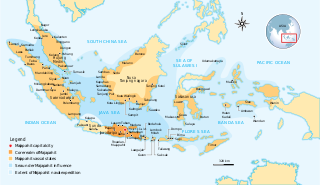
Majapahit, also known as Wilwatikta, was a Javanese Hindu-Buddhist thalassocratic empire in Southeast Asia that was based on the island of Java. It existed from 1292 to c. 1527 and reached its peak during the era of the queen Tribhuvana and her son Hayam Wuruk, whose reigns in the mid-14th century were marked by conquests that extended throughout Southeast Asia. This achievement is also credited to the famous prime minister Gajah Mada. According to the Deśavarṇana written in 1365, Majapahit was an empire of 98 tributaries, stretching from Sumatra to New Guinea; including territories in present-day Indonesia, Singapore, Malaysia, Brunei, southern Thailand, Timor Leste, southwestern Philippines although the scope of Majapahit sphere of influence is still the subject of debate among historians. The nature of Majapahit's relations and influence upon its overseas vassals and also its status as an empire still provokes discussion.
Negara Daha was a Hindu kingdom successor of Negara Dipa that appears in the Hikayat Banjar. It was located in what is now the Regency of Hulu Sungai Selatan, Province of South Kalimantan, Republic of Indonesia.
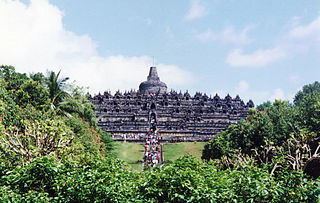
The Wali Songo are revered saints of Islam in Indonesia, especially on the island of Java, because of their historic role in the spread of Islam in Indonesia. The word wali is Arabic for "trusted one" or "friend of God", while the word sanga is Javanese for the number nine.
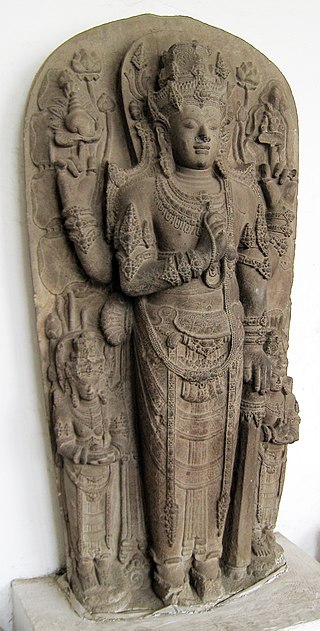
Raden Wijaya or Raden Vijaya, also known as Nararya Sangramawijaya and his regnal name Kertarajasa Jayawardhana was a Javanese emperor and founder of the Majapahit Empire who ruled from 1293 until his death in 1309. The history of his founding of Majapahit was written in several records, including Pararaton and Negarakertagama. His rule was marked by the victory against the army and the Mongol navy of Kublai Khan's Yuan dynasty.
Sunan Kalijaga was one of the "nine saints" of Javanese Islam. The "Kalijaga" title was derived from an orchard known as "Kalijaga" in Cirebon. Other accounts suggest that the name derives from his hobby of submerging himself in Kali. Others note that the name Kalijaga derived its nature from the Arabic notion of qadli dzaqa which means "holy leader" in the sultanate.

The history of the arrival of Islam in Indonesia is somewhat unclear. One theory states that Islam arrived directly from Arabia as early as the 9th century, during the time of the Umayyad and Abbasid caliphates. Another theory credits Sufi travelers for bringing Islam in the 12th or 13th century, either from Gujarat in India or from Persia. Before the archipelago's conversion to Islam, the predominant religions in Indonesia were Hinduism and Buddhism.

The Demak Sultanate was a Javanese Muslim state located on Java's north coast in Indonesia, at the site of the present-day city of Demak. A port fief to the Hindu-Buddhist Majapahit kingdom thought to have been founded in the last quarter of the 15th century, it was influenced by Islam brought by Muslim traders from China, Gujarat, Arabia and also Islamic kingdoms in the region, such as Samudra Pasai, Malacca and Bani (Muslim) Champa. The sultanate was the first Muslim state in Java, and once dominated most of the northern coast of Java and southern Sumatra.
Sunan Bonang was one of the nine Wali Songo, along with his father Sunan Ampel and his brother Sunan Drajat who are said to have established Islam as the dominant religion amongst the Javanese, Indonesia's largest ethnic group.
Sunan Ampel was one the nine revered Javanese Muslim saints, or Wali Songo, credited with the spread of Islam in Java. According to local history, around Demak the mosque of Demak Masjid Agung Demak was built by Sunan Ampel in 1479 CE, but other sources attributed the construction of the mosque to Sunan Kalijaga.

Sumedang Larang is an Islamic Kingdom based in Sumedang, West Java. Its territory consisted of the Parahyangan region, before becoming a vassal state under the Mataram Sultanate.

Raden Patah, also known as Jin Bun was the first sultan of the Demak Sultanate. Ascending to the throne in 1475, he remained a vassal of the Majapahit Empire until 1478. Raden Patah took the title Panembahan Jimbun after legitimizing the Sultanate of Demak as the successor state to the Majapahit Empire, with the Wali Sanga appointing him the Sultan of Demak.

The Kingdomship of Bali was a series of Hindu-Buddhist kingdoms that once ruled some parts of the volcanic island of Bali, in Lesser Sunda Islands, Indonesia. With a history of native Balinese kingship spanning from the early 10th to early 20th centuries, Balinese kingdoms demonstrated sophisticated Balinese court culture where native elements of spirit and ancestral reverence combined with Hindu influences—adopted from India through ancient Java intermediary—flourished, enriched and shaped Balinese culture.
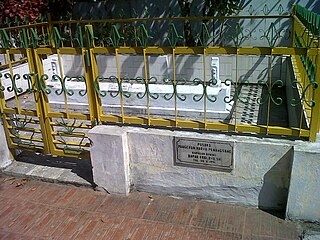
Arya Penangsang was king of the Sultanate of Demak between 1549 and 1554.
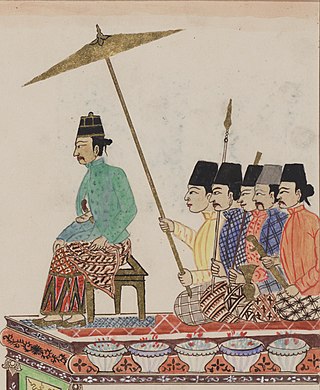
Amangkurat III was a short-lived susuhunan (ruler) of the Sultanate of Mataram, who reigned 1703–1705.
The Demak-Majapahit conflicts or Sudarma Wisuta were a series of conflicts between the rising Demak Sultanate and the waning Majapahit Empire. It marked the defeat of forces loyal to the legitimate Majapahit ruler, Bhre Kertabhumi, by Girindrawardhana, son of Singhavikramavardhana, and the independence of the Demak Sultanate under Raden Patah, sons of Kertabhumi or Bravijaya V. 1478 is used to date the end of the Majapahit Empire. The Sudarma Wisuta was the second biggest war in ancient Java after the Mongol invasion of Java. The war ended in stalemate as Girindrawardhana killed Demak commander and Demak Forces destroyed Girindrawardhana logistics.

Giri Kedaton was an Islamic kedatuan located in Gresik, East Java and existed in the 15th to 17th centuries, until Giri was conquered by the Mataram Sultanate in 1636.
Negara Dipa was a Hindu kingdom in South Kalimantan that appears in Hikayat Banjar. It was located in Amuntai near modern-day Tabasan. It was also the predecessor of Negara Daha and Banjar Sultanate.
Raden Kusen, also known as Kin San was the Duke of Terung and one of the last commanders of the Majapahit Imperial Army. His father was the Duke of Palembang, Arya Damar while his mother was Siu Ban Ci, the former concubine of Majapahit Emperor. He was a half-brother of Raden Patah, the founder of the Demak Sultanate. He supposedly was to succeed his father at the Duchy of Palembang, as the Duke of Palembang, but he along with his brother moved to Java island. His descendants, the sultans of Palembang from the 17th century until 19th century were his rightful successors.
Kertawijaya or Dyah Kertawijaya was the seventh monarch of Majapahit reigning from 1447 to 1451 by the regnal name Sri Maharaja Wijayaparakramawardhana.









